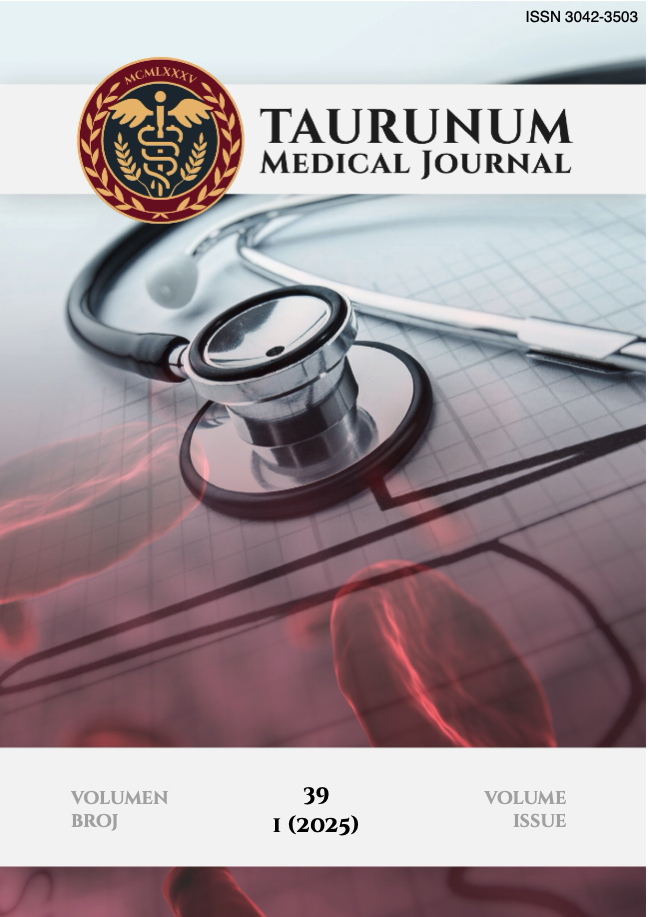Current issue

Volume 39, Issue 1, 2025
Online ISSN: 3042-3511
ISSN: 3042-3503
Volume 39 , Issue 1, (2025)
Published: 31.03.2025.
Open Access
Welcome to Issue 39, No. 1 – the first of our two annual publications for this year. Inside, you'll find a curated selection of articles. Start your year with the essential knowledge and perspectives offered in this timely edition
All issues
Contents
01.04.2018.
Special Session: Residents Session
Detection of co-expression of ATRX and HIF-1alfa in renal tumors - pilot study
Aim: To investigate co-expression of ATRX and HIF-1α in kidney neoplasm in relation to its origin. Introduction: A heterogenous group of kidney tumors is believed to arise from a variety of specialized cells along the nephron – proximal tubules [Clear cell Renal Cell carcinoma (ccRCC) and papillary RCC (pRCC)] and collecting tubules [chromophobe RCC (chRCC) and oncocytoma]. ATP-dependent helicase (ATRX) is a chromatin remodeling protein involved in gene regulation and aberrant DNA methylation during cancerogenesis. Activation of hypoxia inducible factor (HIF-1α) is an early event in most RCC following inactivation of the VHL tumor suppressor gene. Material and Methods: A total of 46 kidney tumors (n=33 ccRCC, n=1 mRCC, n=4 pRCC, n=5 chRCC and n=3 oncocytomas) was immunohistochemically analyzed for ATRX and HIF-1α expression. Results: Diffuse and focal positivity of ATRX expression was found in 51.5% of ccRCC, while 54.5% had HIF-1α positivity. Co-expression of ATRX/HIF-1α was not related to nuclear grade and stage of ccRCC. Metastatic ccRCC had strong expression of both markers. pRCC type II showed weak ATRX/HIF-1α expression, while pRCC type I was negative for both markers. Interestingly, all analyzed oncocytomas and chromophobe RCC were negative for ATRX/HIF-1α. Conclusion: Our results suggest that signaling pathways have different patterns of activation/suppression of ATRX/HIF-1α in oncocytomas and chRCC compared to other RCC types. Downregulation or loss of ATRX/HIF-1α coexpression in benign tumors should be further investigated in order to determinate mechanisms of ATRX/ HIF-1α signaling transport renal neoplasm with different origin.
Gorana Nikolic, Sanja Cirovic, Sanja Radojevic Skodric
01.04.2018.
Poster session
EGFR mutations in lung carcinomas and quality of samples tested at Institute of Pathology, School of Medicine in Belgrade
Aim: To examine the quality of tested lung carcinoma samples, frequency and type of EGFR mutations, and their correlation with patients clinical characteristics (gender, age, smoking habits, clinical stage). Introduction: Mutations in Epidermal Growth Factor Receptor (EGFR) have a role in lung carcinoma development and they are more prevalent in women and non-smokers. Evaluation of EGFR mutations in lung carcinomas in mandatory for targeted therapy with tyrosine kinase inhibitors. Test performance depends on the quality of tested samples and a test type. Material and Methods: We evaluated reports of EGFR mutation real-time PCR analyses in lung carcinoma samples performed from June 2017 till February 2018. Presence of mutations was correlated with clinical characteristics of lung carcinoma patients. Results: A total of 341 samples was received for testing, among which 40 (11.7%) was unsuitable for analysis due to a low tumor cell content (<5%). Three types of mutations were detected in a total of 24 (8%) cases: L858R in 12 (50%) cases, exon 19 deletion in 10 (41.7%) cases, and G719A/C/S in two cases (8.3%). Mutations were more prevalent in women (13.7%) then in men (4.3%) (p=0.004). Patients with EGFR mutated tumors were older (67,6ą9,4 years), compared to those with non-mutated tumors (62,3ą8,8 years) (p=0,003). Smoking habits and clinical stage were not associated with mutation status in lung carcinomas. Mutations were detected only in adenocarcinomas. Conclusion: Our results suggest the low frequency of EGFR mutations in tested patients, but they are more prevalent in women and older patients.
Sanja Cirovic, Sofija Glumac, Nevena Pandrc, Zorica Tojaga, Ivan Zaletel, Jovan Jevtic, Violeta Mihailovic Vucinic, Natalija Samardzic, Sanja Radojevic Skodric, Martina Bosic



